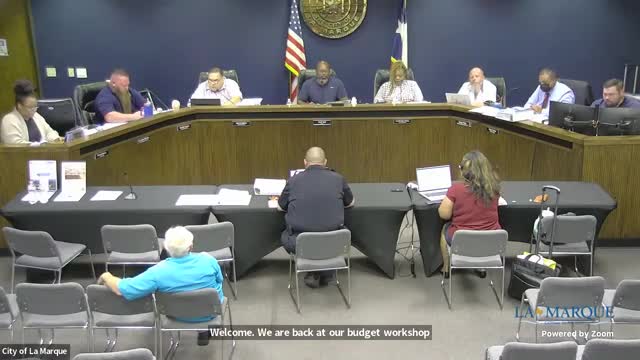Fire Chief reveals staffing crisis and budget challenges
August 19, 2024 | La Marque, Galveston County, Texas
This article was created by AI summarizing key points discussed. AI makes mistakes, so for full details and context, please refer to the video of the full meeting. Please report any errors so we can fix them. Report an error »

During a recent government meeting, Fire Chief Mayorman addressed pressing concerns regarding the fire department's budget and staffing needs. The chief revealed that the department's overtime budget remains at $300,000, despite a request for $350,000. He explained that the majority of this overtime is necessary to maintain minimum staffing levels due to absences from sick leave, vacations, and injuries, which often leave the department short-staffed.
Currently, the department operates with a minimum staffing of eight personnel, which is still below the state and National Fire Protection Association (NFPA) standards that recommend four personnel per fire engine. Chief Mayorman noted that approximately 95% of the overtime costs are attributed to maintaining this minimum staffing, emphasizing the critical need for additional personnel to ensure safety and compliance with regulations.
The chief also discussed the department's recent improvement in its Insurance Services Office (ISO) rating, which moved from a level four to a level two due to enhanced staffing and operational strategies. However, to achieve an even better rating of one, the department needs to increase its staffing further, particularly to support four-person engine crews. The chief proposed a phased hiring plan to add three engineers and three firefighters, which would help address staffing shortages without overwhelming the training process.
Additionally, the chief highlighted the importance of acquiring a ladder truck, which would not only improve response times for high-rise incidents but also attract new commercial developments to the area. Currently, the absence of a ladder truck limits the city's ability to permit buildings over four stories, as developers often require such equipment for fire safety.
The meeting concluded with discussions on automatic aid agreements with neighboring cities, which enhance response times for structure fires by ensuring that additional resources are dispatched automatically. This collaborative approach aims to improve overall fire response efficiency and safety for the community.
Currently, the department operates with a minimum staffing of eight personnel, which is still below the state and National Fire Protection Association (NFPA) standards that recommend four personnel per fire engine. Chief Mayorman noted that approximately 95% of the overtime costs are attributed to maintaining this minimum staffing, emphasizing the critical need for additional personnel to ensure safety and compliance with regulations.
The chief also discussed the department's recent improvement in its Insurance Services Office (ISO) rating, which moved from a level four to a level two due to enhanced staffing and operational strategies. However, to achieve an even better rating of one, the department needs to increase its staffing further, particularly to support four-person engine crews. The chief proposed a phased hiring plan to add three engineers and three firefighters, which would help address staffing shortages without overwhelming the training process.
Additionally, the chief highlighted the importance of acquiring a ladder truck, which would not only improve response times for high-rise incidents but also attract new commercial developments to the area. Currently, the absence of a ladder truck limits the city's ability to permit buildings over four stories, as developers often require such equipment for fire safety.
The meeting concluded with discussions on automatic aid agreements with neighboring cities, which enhance response times for structure fires by ensuring that additional resources are dispatched automatically. This collaborative approach aims to improve overall fire response efficiency and safety for the community.
View full meeting
This article is based on a recent meeting—watch the full video and explore the complete transcript for deeper insights into the discussion.
View full meeting
